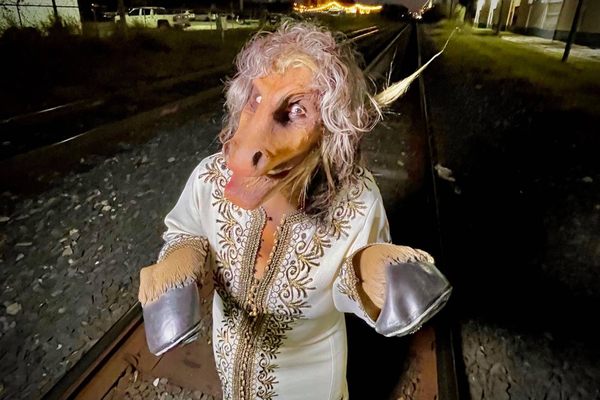In Indonesia, Non-Binary Gender is a Centuries-Old Idea
Modern Western culture is slowly acknowledging gender fluidity, but “third genders” and other classifications have existed throughout history.

Bissu attending an Indonesian wedding. (Photo: Sharyn Davies/CC-BY-2.0)
This week, an Oregon judge ruled to allow Jamie Shupe, a 52-year-old former Army mechanic, to list themselves as non-binary—that is, neither male nor female on their driver’s license. The ruling is likely the first time that an individual has been allowed to legally identify as non-binary in the United States, and represents part of a growing effort around the world to extend legal recognition to those whose identities fall outside the masculine/feminine gender binary.
Some might assume that the shift towards viewing gender as fluid or encompassing identities beyond the binary is a novel cultural change; in fact, several non-Western cultures—both historically and today—have non-binary understandings of gender. In Indonesia, one ethnic group shows us that the idea that gender identity is expressed in more ways than two is actually hundreds of years old.
The Bugis are the largest ethnic group in South Sulawesi, Indonesia, and are unique in their conception of five distinct gender identities. Aside from the cisgender masculinity and femininity that Westerners are broadly familiar with, the Bugis interpretation of gender includes calabai (feminine men), calalai (masculine women) and bissu, which anthropologist Sharyn Graham describes as a “meta-gender” considered to be “a combination of all genders.” In a 2002 article for the International Institute of Asian Studies’ Newsletter, Graham explains the key role bissu play in Bugis culture.
If you were to ask someone in South Sulawesi how they imagine their world came to be, you would probably be told a narrative in which the bissu play a central role.
‘You ask how this world came to be? Well let me tell you. Up there in the heavens, the gods decided they would bring life to this lonely planet. They therefore sent down one of their most aspiring deities, Batara Guru. But Batara Guru was not good at organizing things. To do all of this, two bissu were needed. So the gods sent down two bissu who flanked Batara Guru as he descended. And when they arrived, the bissu set about making everything blossom; they created language, culture, customs [adat], and all of the things that a world needs if it is going to blossom. That’s how the world began you see’ (Haj Bacco’).
Bissu purposefully dress in ways that blend traditional male and female characteristics (Graham provides an example of a bissu wearing a traditionally masculine knife while also wearing flowers in their hair) and have existed in Bugis culture since before Islam arrived in Indonesia in the 13th century. Even today, bissu play an important role in local communities by providing blessings—at marriages, before harvests, and even before Bugis Muslims make the pilgrimage to Mecca. To the Bugis, bissu are not just a blend of masculine and feminine, they are also a mixture of mortal and deity, able to become possessed by the spirits through elaborate, dangerous rituals.
Sadly, bissu were persecuted and suppressed under Islamic fundamentalist and Communist regimes following Indonesia’s independence from Dutch rule in 1949. A 2015 Al Jazeera article detailed anthropologist Halilintar Lathief’s efforts to revive the bissu presence and role in Bugis communities, inaugurating the first new bissu in decades in 2002. In the town of Sigeri, for example, “being bissu is now intertwined with gay and transgender identity,” although many view becoming a bissu as an unnecessary hardship as calabai and other non-binary individuals now have greater economic opportunities working in salons or as wedding planners.
Around the world, individuals who identify outside of the gender binary are seeing increasing legal and social recognition. In 2014, South Asia’s 4,000-year-old hijra third-gender community won a hard-fought victory when the Indian Supreme Court declared discrimination against hijra illegal and instituted a third gender option on government documents (the hijra have also won this right in Nepal, Pakistan, and Bangladesh). Australia has allowed a third gender option on passports since 2011, and in the United Kingdom, the proliferation of the option to use the “Mx” title on government and bank documents encouraged the Oxford English Dictionary to officially add the honorific last year.
While there are still many institutions where the gender binary remains the only option, these incremental steps are immensely meaningful for those affected. As Shupe told NPR’s All Things Considered, “Most of the excitement is feeling the freedom of being set free of this classification system that I do not agree with.” And, as seen with the Bugis, it’s a classification system that’s not as universal as some might think.










Follow us on Twitter to get the latest on the world's hidden wonders.
Like us on Facebook to get the latest on the world's hidden wonders.
Follow us on Twitter Like us on Facebook